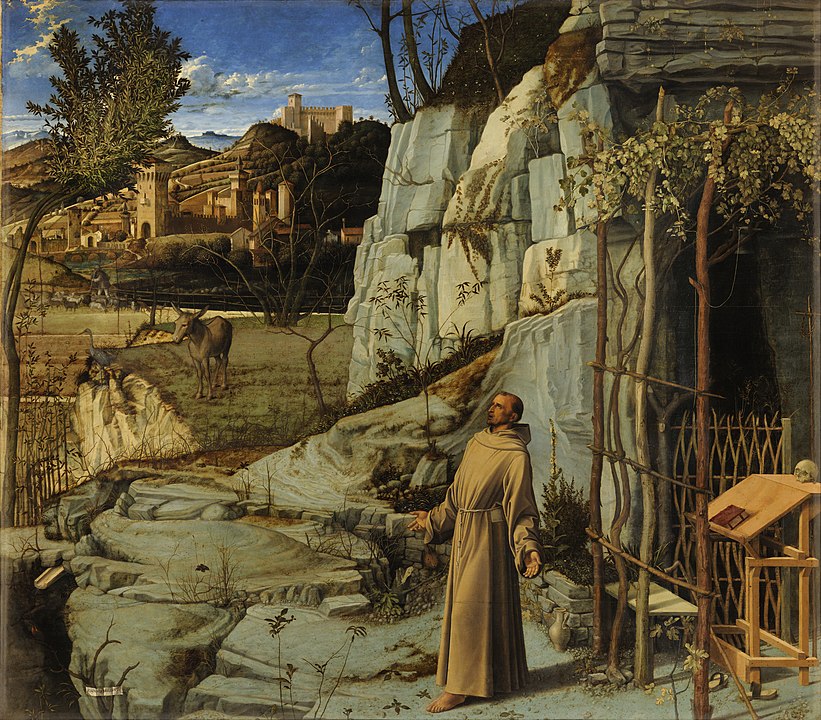
“St Francis in the Desert”, c.1480, Giovanni Bellini, Frick Collection, New York.
The use of the word “desert” in the title of this painting belies the landscape it depicts. St Francis is positioned in a landscape which includes a fortress, a walled town, a river, a shepherd with his flock, a donkey, a grey heron, and almost hidden on the bottom left, a small bird drinking from a spring of water. It teems with natural life. But a closer look at the laurel tree on the left reveals that there are two sources of light in this scene. There is the normal sun light which is perhaps that of early morning sunshine coming from the left and catching the walls of the fortress, the town and the donkey in the middle distance. But the laurel tree and St Francis are lit by a much stronger light. Curiously, this light casts a long shadow behind the saint but not the tree. The bright light suggests that what Bellini shows us is St Francis in prayer. There is sympathy between the saint and his surroundings. For example, he rock face behind the saint echoes his posture as does the laurel tree which leans to the right. Of course, this expresses the saint’s sense of being in harmony with the natural world. But it should be remembered that Bellini always invented his landscapes and often the elements in them are imbued with symbolism. The laurel tree may be included to evoke the laurel wreath worn by the winners in the stadium and so allude to the comparison which St Paul makes in the First Letter to the Corinthians between the competitors in the stadium who complete for a wreath that will wither, and the Christian who competes for a prize that will never fade away (1 Cor 9:25). But it isn’t just the laurel tree. With each element of this landscape the artist attempts to externalise the interior world of the saint. The heron and the ass for example are thought to evoke his solitude, prayer and penance. But others are less easily understood at this distance in time and culture. For example, Bellini painted plants accurately so that they were easily identified. Those growing on the small raised bed behind the saint are known to have been used in medicine. Are they included to suggest healing or have they some other significance? Nevertheless, the meaning of some elements are more easily understood. It is known that Franciscan authors sought to show St Francis as being the new Moses. The brightly lit laurel tree, which does not cast a shadow, may be there to represent the burning bush. St Francis is barefoot as was Moses before the burning bush, because he knew himself to be standing on holy round. Near him there is the dead stump of a fig tree which has been cut down, perhaps to suggest that the old order id dead. But another stump has an olive branch grafted on, perhaps to symbolise Christ. One curious detail which is less easy to interpret is the rabbit looking out from a hole in the stone wall just under St Francis’ right hand. Some scholars suggest that the rabbit represents Moses who was silent before the Lord! In any case, we will celebrate the Feast of St Francis on Saturday.
St Francis pray for us.
The Catholic Chaplaincy serves the students and staff of the University of Edinburgh, Edinburgh Napier University and Queen Margaret University.
The Catholic Chaplaincy is also a parish of the Archdiocese of St Andrews and Edinburgh (the Parish of St Albert the Great) and all Catholic students and staff are automatically members of this parish.